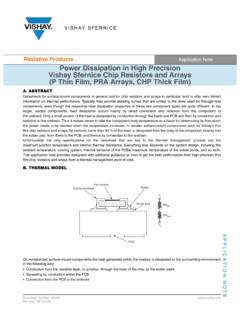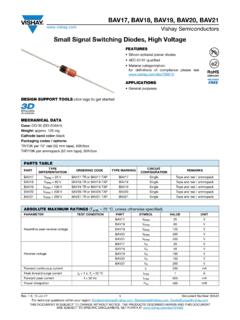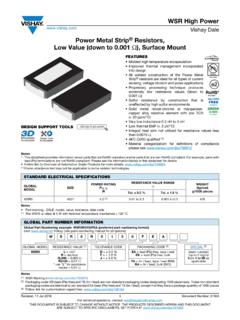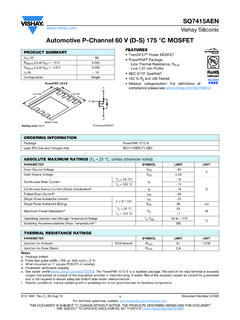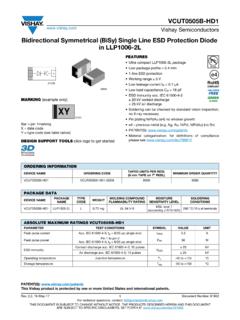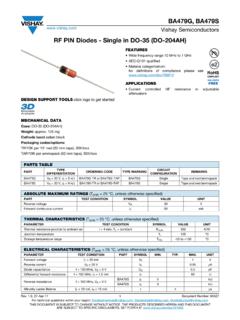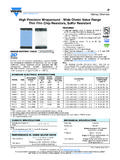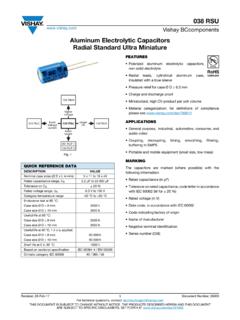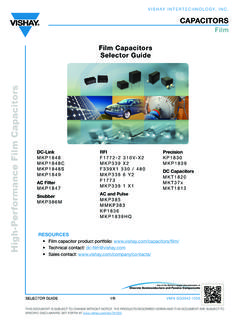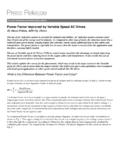Transcription of How to Select the Right MOSFET for Power Factor Correction ...
1 vishay SILICONIX. Power MOSFETs Application Note - AN844. How to Select the Right MOSFET . for Power Factor Correction applications Power Factor is the ratio of the real Power (P = Watts) to the apparent Power (VA = Volt Ampere); the goal is to achieve a Power Factor as close to 1 as possible. A load with a lower Power Factor draws more reactive current than a load with a higher Power Factor for the exact same output Power . The higher current increases the energy lost within the system, and for utility companies, results in excessive wasted Power in transmission.
2 For this reason, a Power Factor Correction (PFC) circuit block, shown in figure 1, is an important, and often mandatory, sub-system of any Power supply with an output Power of 75 W or more (per EN61000-3-2). A PFC circuit block is used to align the input line current with the AC voltage waveforms, and in most cases boosts the output voltage to a common 400 VDC. Figures 2 and 3 shows the impact of a PFC circuit on the line current and its harmonics. Fig. 1 - PFC Schematic APPLICATION NOTE. Fig. 2 - Line Voltage and Current without PFC Fig.
3 3 - Waveforms with PFC. In figure 2, current is drawn from the AC supply only for a Figure 3 shows the benefits of implementing PFC using the short duration of the cycle. This results in a poor Power same input Power profile. With a Power Factor of %, Factor and excessive harmonics of 115 %. While the system harmonics are down to 3 %. Current is drawn from the AC. draws only 158 W of usable Power , 272 Volt-Amperes are line throughout the cycle and no excessive Volt-Amperes circulated in the transmission system to deliver it.
4 Are wasted. Revision: 03-Jun-13 1 Document Number: 65677. For technical questions, contact: THIS DOCUMENT IS SUBJECT TO CHANGE WITHOUT NOTICE. THE PRODUCTS DESCRIBED HEREIN AND THIS DOCUMENT. ARE SUBJECT TO SPECIFIC DISCLAIMERS, SET FORTH AT Application Note - AN844. vishay Siliconix How to Select the Right MOSFET . for Power Factor Correction applications It should be noted that PFC and harmonic current reduction switching loss is incurred both ways, as Coss is charged are not synonymous. For example, in a highly inductive load, when the device turns off and discharged when it is turned the current may be a perfect sinusoid lagging the voltage.
5 It on, and has to be taken into account in the design. The will then have a poor Power Factor and high reactive Power larger the Coss/Qoss, the larger the switching losses. In without any harmonics at all. Whereas a distorted waveform, addition, the Qoss loss is fixed and independent of load, as rich in harmonic currents, usually has all the undesirable can be seen by the standard equation Poss = CV2 x Fsw, features. The PFC circuit corrects more than just the Power where Fsw is the switching frequency.
6 Factor ; it reduces the harmonics. Today, there are different In universal input Power supplies, the PFC MOSFET is standards specifying the quality of Power drawn by always subjected to the bulk DC bus voltage of 380 VDC to electronic equipment. EN61000-3-2 requires harmonic 400 VDC. As a result, the output switching loss can be a current reduction on all systems with input Power of > 75 W. significant portion of the total losses. The Coss of a 80 Plus Power supply certification requires a Power Factor of high-voltage MOSFET (HVM) varies considerably with the or more.
7 Applied VDS. This variation is much wider for high-voltage In a PFC circuit, the MOSFET is responsible for Super Junction Power MOSFETs than for planar types. To approximately 20 % of all losses. By choosing the correct account for the non-linearity of the output capacitor, device, PFC efficiency can be greatly increased. One way to Poss = Coer x V2 x Fsw may be used as the loss equation. Select the Right MOSFET for a PFC circuit is by using an Coer is the effective capacitance that has the same stored application-specific Figure of Merit (FOM) that is focused on energy and same losses as the integrated Coss of the minimizing total losses in the device.
8 While it includes MOSFET , and is provided in the datasheets. So, the new on-resistance (RDS(on)) for conduction losses and gate FOM will now look like RDS(on) (typ.) * (Qswitch (typ.) + Qoss), charge (Qg) for switching losses, the FOM is not a simple where Qswitch is a combination of Qgd and Qgs. product of the two. In order to account for switching losses, As an example, we will use a TO-220 device with a a portion of the device's Qgs and Qgd, along with its output maximum package Power loss of 10 W, and contribute 5 W.
9 Capacitance (Coss), are used. to conduction losses and 5 W to switching losses. The The four stages of a standard AC/DC Power supply are: Coss/Qoss losses would contribute to approximately 20 % of Input the overall package loss, or 40 % of the total switching losses, which is a large loss that is not taken into account PFC Front End with the standard FOM equation. With this in mind we have Converter developed a list of components that we feel will achieve the Secondary highest efficiency for a PFC design based on the following operating conditions (see table 1) to help our customers To meet 80 Plus Gold efficiency standards, the combined develop the most efficient design possible.
10 Loss for all stages is ~ 12 % of the rated output Power . The PFC MOSFET alone should be limited to around 2 % of the total output Power or the package Power limit, whichever is TABLE 1 - Power Factor Correction . lower. The maximum Power loss limits of TO packages DESIGN CONDITIONS. are: Input Voltage 100 V. TO-220 / TO-220F: 10 W/8 W Output DC Voltage 400 V. TO-247: 20 W PFC Switching Frequency 65 kHz MOSFET Drive Voltage 12 V. Super TO-247 / Tmax.: 25 W. On/Off Gate Current Range A (25 W) to A (475 W).

